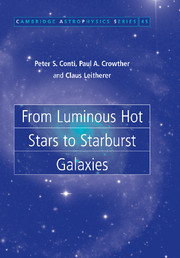Book contents
- Frontmatter
- Contents
- Preface
- Acknowledgements
- 1 Introduction
- 2 Observed properties
- 3 Stellar atmospheres
- 4 Stellar winds
- 5 Evolution of single stars
- 6 Binaries
- 7 Birth of massive stars and star clusters
- 8 The interstellar environment
- 9 From giant HII regions to HII galaxies
- 10 Starburst phenomena
- 11 Cosmological implications
- References
- Acronyms
- Symbols
- Object index
- Subject index
3 - Stellar atmospheres
Published online by Cambridge University Press: 28 October 2009
- Frontmatter
- Contents
- Preface
- Acknowledgements
- 1 Introduction
- 2 Observed properties
- 3 Stellar atmospheres
- 4 Stellar winds
- 5 Evolution of single stars
- 6 Binaries
- 7 Birth of massive stars and star clusters
- 8 The interstellar environment
- 9 From giant HII regions to HII galaxies
- 10 Starburst phenomena
- 11 Cosmological implications
- References
- Acronyms
- Symbols
- Object index
- Subject index
Summary
A detailed discussion of stellar atmospheres is beyond the scope of this book. Nevertheless, our means of studying the properties of hot massive stars relies upon our ability to properly interpret the stellar continuum and line information typically formed in the thin boundary layer between the unseen interior and effectively vacuum interstellar medium. An excellent monograph on the topic of stellar photospheres is provided by Gray (2005), whilst more advanced techniques are introduced by Mihalas (1978).
With respect to normal stars, our interpretation of hot, luminous stars is hindered by two effects. Firstly, the routine assumption of LTE breaks down for high-temperature stars, and particularly for supergiants, due to the intense radiation field, such that the solution of the statistical rate equations (non-LTE) is necessary. Secondly, the simplifying assumption of plane-parallel geometry is no longer valid for blue and red supergiants, so the scale heights of their atmospheres are no longer negligible with respect to their stellar radii. It is the combination of requiring non-LTE plus spherical geometry that has prevented the routine study of OB star atmospheres until recently.
LTE atmospheres
Effective temperatures of early-type stars, essential for subsequent determinations of radii and luminosities, are derived from a comparison between observed photometry and/or spectroscopy and models. Surface gravities also require comparison between observed line profiles and models.
LTE model atmospheres developed by Robert Kurucz during the 1970s and 1980s account very thoroughly for metal line blanketing and are widely employed for both early- and late-type stars.
- Type
- Chapter
- Information
- From Luminous Hot Stars to Starburst Galaxies , pp. 49 - 66Publisher: Cambridge University PressPrint publication year: 2008



